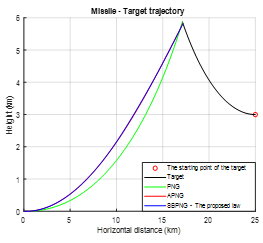Synthesis of the Switched Bias Proportional Navigation Guidance Law to Destroy Complexly Maneuvering Targets
Keywords:
Guidance law, Homing missile, Maneuver, Proportional navigation, TargetAbstract
This paper presents the results of synthesis of guidance law for homing missile to destroy highly and complexly maneuvering targets. The aim is to realize the guidance methods applied to modern homing missiles. The algorithm is simple, highly convergent, stable and has small errors. The efficiency of the algorithm is verified through simulation, the results are reliable. New guidance law for short range flight missiles, based on the theory of variable mode structure. The new guidance law is built around the basic the proportional navigation guidance law with a switched bias added to the guidance law to bring the line of sight angle towards zero, even when the target is maneuvering.
Downloads
References
H. Jin Kim and Min-Jea Tahk, “Fast Adaptive Guidance Against Highly Maneuvering Targets”, Korea Advanced Institute of Science and Technology (KAIST) Daejeon, Korea, 2008.
K. Ravindra Babu, I.G.Sarma, “Switched bias proportional navigation for homing guidance against highly maneuvering targets”, Journal of Guidance, Control, and Dynamics, Vol.17, No.6, pp. 1357-1363, 2004.
Moon, J., Kim, K., and Kim, Y, “Design of missile guidance law via variable structure control”, Journal of Guidance, Control, and Dynamics, Vol.24, No.4, pp. 659-664, 2015.
Neil F. Palumbo, Ross A. Blauwkamp, and Justin M. Lloyd, “Modern Homing Missile Guidance Theory and Techniques”, Johns Hopkins APL Technical Digest, Vol.29, No.1, pp.1367-1385, 2010.
Paul Zarchan., “Tactical and Strategic Missile Guidance”, Progress in Astronautics and Aeronautics, American Institute of Aeronautics and Astronautics, Inc., Washington, D.C, Vol.2, 2002.
Liu T., Xie Y, “A relative navigation algorithm for a chaser tracking a non-cooperative maneuvering target in space”. Vol 31, No5, pp. 1338–1344, 2016.
Jiyuan L., Jun Z., Yingying L, “Applying auto-adaptation filter to tracking of maneuvering target in special relative navigation”, J. Northwest, Polytech. Univ. 4, 013, 2018.
Bar S. Y., RongLi X., Kirubarajan T. “Estimation with Applications to Tracking and Navigation. Theory Algorithms and Software” John Wiley & Sons, 2001.
Blackman S., Popoli R, “Design and analysis of modern tracking systems”, Artech House, 1999.
Shaofeng M., Xinxi F., Yulei L., Zhang W., Xiaomei Z, “A variable dimension adaptive IMM tracking algorithm”, Electron. Opt. Control 22. (02), pp. 36-45, 2016.
Xiu L. H., Jing S. Y, “Curve Model of Adaptive Interaction Model Algorithm Tracking Method”, Applied Mechanics and Materials, Vol 738-739, pp. 344-349, March 2018.
Jiangw L.V.Z.., Lan Y, “IMM-CKF algorithm based on variable dimension interaction”, Comput. Appl. Softw, 30(5). 4–6, 2017.
Nguyen N. T., Nguyen D. T., Nguyen V. B, “Synthesis of remote control law when taking into dynamics and nonlinearity of the missile stage”, Intelligent Systems and Networks (ICISN 2021), Springer, pp. 171-180, March 2021.
Xiong, K., Wei, C, “Spacecraft relative navigation based on multiple model adaptive estimator”, J. Syst. Sci. Math. Sci. 34(07), pp. 828–837, 2018.
Le X.R., Kilkov V.P. “A survey of maneuvering target tracking: Approximation techniques for nonlinear filtering”, Proceedings of SPIE conference on signal and data processing of small targets, pp. 537-550, 2014.
Li X.R., Jilkov V.P. “Survey of maneuvering target tracking-part V”. IEEE transaction on aerospace and electronic system, 41 (4), pp. 1255-1321, 2015.
Xu B. “An adaptive tracking algorithm for bearings-only maneuvering target”, International journal of computer science and network security, 7 (1), 2017.
Yang C. C., Tsung T. K, “An interactive dynamic multi-objective programming model to support better land use planning”, Land Use Policy, Elsevier, Vol.36, pp. 13-22, 2016.
Qian G.H., Li, Y., Luo, R.J. “One maneuvering frequency and the variance adaptive filtering algorithm for maneuvering target tracking”, J. Radars 2(6), pp. 258–264, 2017.
Nguyen V. B., Nguyen T. T., Dang T. T, “Synthesis of parameter recognition algorithm and state evaluation for flight device”, East European Scientific Journal, Vol 2. No.66, pp. 10-17, 2021.
Nguyen V. B., Dang C. V. “Synthesis of the maneuver target acceleration determines algorithm”, Journal of natural and technical sciences, Sputnik Publishing House, No.2 (153), pp. 145-156, 2021.
Wu N.E., Youmin Z., Kermin Z. Detection, “Estimation and accommodation of loss of control effectiveness”, International journal of adaptive control and signal processing, 14, pp. 775-795, 2010.
Kim, H.S., Park, J.G., Lee, D, “Adaptive fuzzy IMM algorithm for uncertain target tracking”, Int. J. Control Autom. Syst. 7(6), pp. 1001–1008, 2017.
Jiadong R., Xiaotong Z, “Interactive multi-model target Maneuver tracking method based on the adaptive probability correction”, International Conference on Swarm Intelligence, ICSI, pp. 235-245, 2018.
Ming-Hsiung Hsueh, Chin-I Huang, Li-Chen Fu, “A Differential Game Based Guidance Law for the Interceptor Missiles”, Industrial Electronics Society, IECON, 33rd Annual Conference of the IEEE, pp.665-670, 2017.

Downloads
Published
How to Cite
Issue
Section
License

This work is licensed under a Creative Commons Attribution-ShareAlike 4.0 International License.
All papers should be submitted electronically. All submitted manuscripts must be original work that is not under submission at another journal or under consideration for publication in another form, such as a monograph or chapter of a book. Authors of submitted papers are obligated not to submit their paper for publication elsewhere until an editorial decision is rendered on their submission. Further, authors of accepted papers are prohibited from publishing the results in other publications that appear before the paper is published in the Journal unless they receive approval for doing so from the Editor-In-Chief.
IJISAE open access articles are licensed under a Creative Commons Attribution-ShareAlike 4.0 International License. This license lets the audience to give appropriate credit, provide a link to the license, and indicate if changes were made and if they remix, transform, or build upon the material, they must distribute contributions under the same license as the original.





